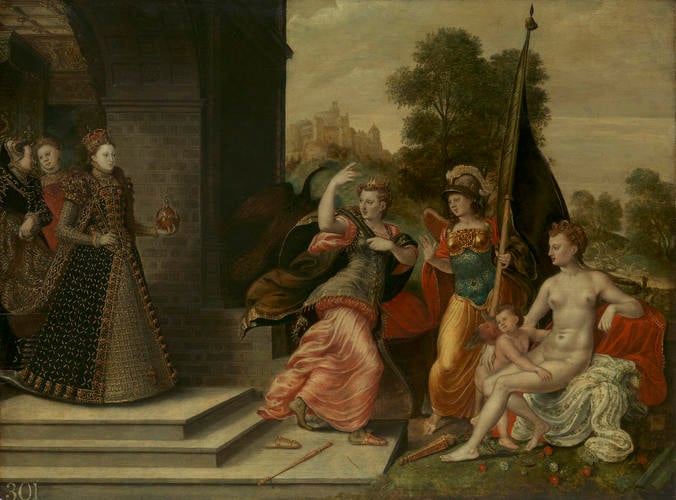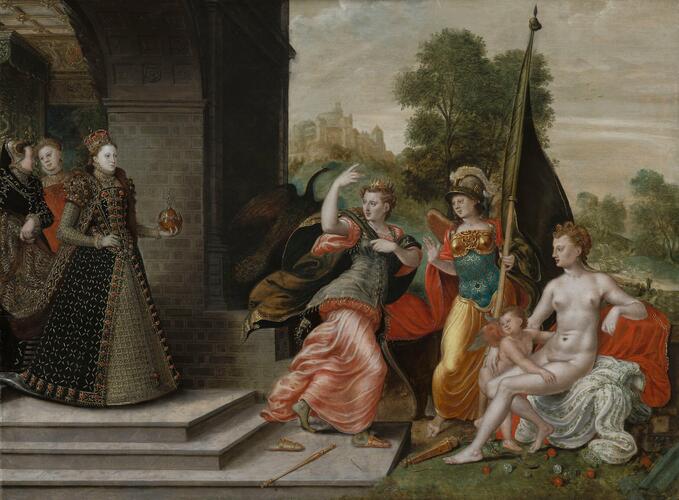-
1 of 253523 objects
Elizabeth I and the Three Goddesses 1569
Oil on panel | 62.9 x 84.4 cm (support, canvas/panel/stretcher external) | RCIN 403446

Hans Eworth (d. 1574)
Elizabeth I and the Three Goddesses 1569


-
Important figures at court were often portrayed in the flattering guise of mythological gods. Elizabeth I is Paris in this re-telling of the beauty contest ‘The Judgement of Paris’. The original myth saw Venus as victor over her rivals Juno and Minerva. Here, Elizabeth I keeps the prize (an orb instead of an apple) for herself, symbolising her triumph over the illustrious goddesses.
Signed and dated lower right: 1569 / HE
The painting is in its original frame which has the contemporary inscription: `IVNO POTENS SCEPTRIS ET MENTIS ACVMINE PALLAS / ET ROSEO VENERIS FVLGET IN ORE DECVS / ADFVIT ELIZABETH IVNO PERCVLSA REFVGIT OBSVPVIT PALLAS ERVBVITQ VENVS'. Translated as: 'Pallas was keen of brain, Juno was queen of might, / The rosy face of Venus was in beauty shining bright, / Elizabeth then came, And, overwhelmed, Queen Juno took flight: / Pallas was silenced: Venus blushed for shame'.
We know that this remarkable painting belonged to Elizabeth herself because a visitor, Baron Waldstein, saw it at Whitehall Palace in 1600. The artist divided the painting into the real, contemporary world on the left and the allegorical world of goddesses on the right. On the left, the Queen stands on the steps and is emerging through a classical arch from a royally decorated interior containing a frieze with the Tudor arms and a canopy embroidered with her own arms. On the far right is the chariot of Venus drawn by swans. The building in the background is thought to be the earliest painted representation of Windsor castle.
This is the only known portrait of Elizabeth I wearing gloves. She is known to have been particularly proud of her elegant hands and used gloves as a sign of favour, removing them to allow a courtier to kiss the royal hand or presenting them as gifts. The goddess Venus on the right has discarded her linen smock, the layer of clothing worn closest to the skin. Unlike the goddess, this garment is not an invention of the artist, demonstrating many of the features seen on surviving smocks of the period, such as bands of embroidery in coloured silk thread.
Hans Eworth was listed as ‘Jan Euworts' in 1540 as a freeman of the Guild of St Luke (St Luke was the patron saint of painters) in Antwerp, but by 1545 he had moved to England where he remained until his death in 1574. As well as working for the Office of Revels, designing sets and costumes for Elizabeth I’s court entertainments, Eworth also produced complex allegorical and religious works.Provenance
Presumably painted for Elizabeth I or presented to her as a gift from a courtier; sold to Hunt and Bass for £2 on 1 March 1653 from the Galleries at Greenwich (no 86); recovered at the Restoration and listed in the King's Gallery at Hampton Court in 1666 (no 132)
-
Creator(s)
Acquirer(s)
-
Medium and techniques
Oil on panel
Measurements
62.9 x 84.4 cm (support, canvas/panel/stretcher external)
83.0 x 103.6 x 8.1 cm (frame, external)
Other number(s)
Alternative title(s)
Elizabeth I confounding the Three Goddesses